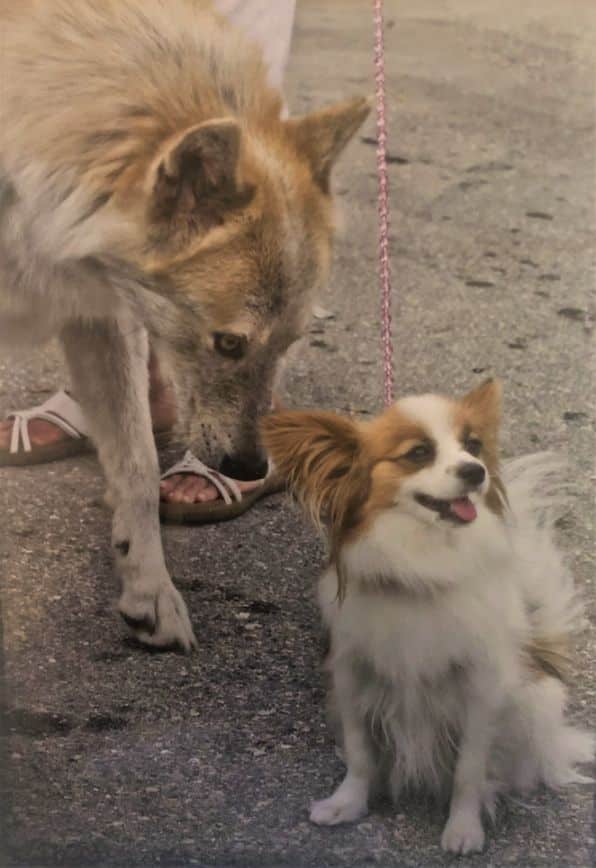Can Toy Dogs Be Prey ? Dear reader, as you check out this photo you are probably thinking that I am the most irresponsible dog owner on the planet. Yes, that is my little Papillon and she is blissfully ignorant of the wolf that is eye-stalking her. The wolf, however, was from Shy Wolf Sanctuary and was acting as an ambassador for the shelter at a local “Woofstock” dog event. We were assured that she was totally safe around dogs, so no Papillons were harmed during this photo shoot!
As we are out and about with our Toy breed dogs, we should be very aware that they do resemble the prey that some larger dogs were bred to hunt. I had an experience at a dog show recently that opened my eyes to this danger.
Now, when walking my Paps around at a show, I am extremely vigilant around large dogs. I am especially careful around some of the breeds that have a reputation for aggression, and am careful to keep my distance.
But one day, I was coming in from the parking lot to a dog show with two Papillons on lead, while my husband was far behind dealing with the crates and dolly. Though I had no fear, I got just a tad too close to a pair of Sighthounds. They were so lovely, with such soft expressions and silky coats. I was smitten—but what was I thinking? Sighthounds were bred to chase down hares and other small mammals. What was I bringing into their line of vision, but two very hare-like creatures complete with big ears and white tails!
Folks, we had a moment. Those Sighthounds went into full prey mode and the eye-stalking and crouching began in earnest. Thankfully, their handler kept them on a very short lead and had excellent voice control over them. I quickly learned that my vigilance should extend to any dog that was bred to hunt small mammals.
Predatory behavior follows a sequence: Search (eye), Stalk, Chase, Bite (grab-bite, kill-bite), Dissect, Consume. However, it is important to understand that prey drive is NOT the same as aggression. Studies using electrical stimulation of the brain have shown that predatory behaviors are enjoyable to dogs, while aggressive behaviors are not. All dogs have a predatory part of the brain, but it is completely separate from the part of the brain that controls aggressive behavior. A predatory dog doesn’t threaten. There will be no warning growl or bark.
So, which breeds have a high prey drive? The predatory instinct has been preserved in the Sporting breeds, as Pointers search out their prey and point to it, Retrievers find and retrieve prey, and Spaniels locate prey and flush it out of hiding. The Herding breeds stalk, creep, chase, and nip. Scenthounds follow the scent trails of the prey, while Sighthounds excel in the pursuit and capture. Terriers were bred to control vermin with the grab-bite, kill-bite.
Just about any small animal (including a Toy dog) can trigger a predatory response in a large dog. When the animal is really small, such as a lizard, squirrel or chipmunk, then the Toy dog can become the predator. I can attest to the hunting skill of my Papillon bitch. She can literally hear mole crickets singing underground in their burrows! She will search, pounce, and dig to find them. We have all seen our Toy dogs chase tennis balls (pursuit), shake their stuffed toys (neck breaking), and chomp down on squeaky toys that sound like a small mammal in distress.
We must acknowledge that even the most gentle and obedient dog has predatory behavior as part of his nature. Keep this in mind to avoid dangerous situations for your Toy dog!
Can Toy Dogs Be Prey ? Just Judy’s Thoughts
(Photo by Rattigan Group LLC)









